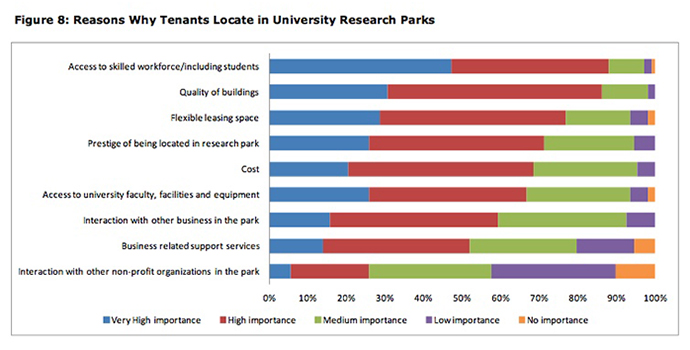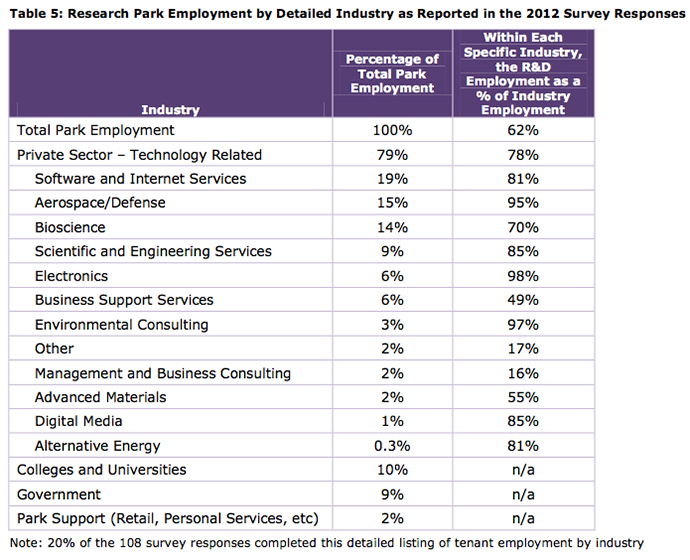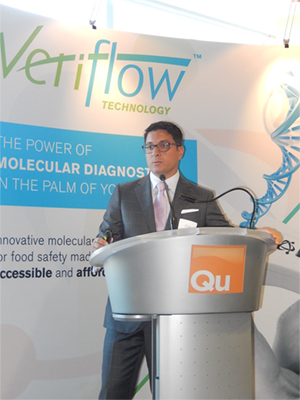The typical university research park is 119 acres (just over 48 hectares), has seven buildings open and is located in a suburban jurisdiction with a population of 500,000 or less.
But urban-style live-work-play campuses are where they’re going, typified by Centennial Campus (affiliated with North Carolina State University), Mission Bay (affiliated with the University of California San Francisco) and the Fitzsimons Life Science District in Colorado (affiliated with the University of Colorado’s academic medical center).
Those findings and more are found in “Driving Regional Innovation and Growth,” an August 2013 report based on the 2012 Survey of North American University Research Parks performed by Battelle’s Technology Partnership Practice for the Association of University Research Parks (AURP). Among other findings:
- Thirteen percent of the 108 university research parks responding to the 2012 survey were formed since 2008. These 14 new university research parks have a current build-out of 3.2 million sq. ft. (297,280 sq. m.) and directly support 3,526 jobs. Eighty of the 108 university research parks surveyed (74 percent) have opened a new building since 2008.
- Of the 85 university research parks that responded to the employment portion of the survey in both 2007 and 2012, 64 percent gained employment from 2007 to 2012.
- Thirty-two percent of university research parks serve communities of 100,000–499,999; 29 percent serve communities with a population of fewer than 100,000, 23 percent serve populations of a million or more; and 17 percent serve populations of 500,000–999,000.
- There has been rapid growth in the development of university research parks over the past decade, with 40 percent of existing university research parks forming between 2000 and 2009.
- Overall, 23 percent of research parks are located in distressed communities, but for university research parks located in urban jurisdictions, 45 percent are located in distressed communities, indicating the importance of university research parks in urban redevelopment efforts across the country. “Key examples of urban redevelopment efforts centered around research parks include the development of the University of Maryland BioPark and the Science and Technology Park at Johns Hopkins, both in Baltimore, Maryland, and CORTEX research park in St. Louis, Missouri, affiliated with Washington University and St. Louis University,” said the report.
- While only 7 percent of university research parks offer non-student housing, 21 percent of parks are planning such developments within the next five years.

Source: AURP/Battelle report
Meaningful Commitments
The 108 university research parks responding to the survey report that 963 new businesses have graduated from their incubators or related startup space in the last five years. The footprint of the parks leans heavily toward the East Coast. Two that stand out for their longevity continue to stand out because of new growth.
University City Science Center in Philadelphia, founded in 1963, is home to such innovative concepts as the Port business incubator for emerging international technology companies; the Bullpen, which is focused on small startups; and its Quorum series of programs and networking activities.

The AURP/Battelle study found which industries are represented most frequently on research park property, with life sciences a leading sector.
Source: AURP/Battelle report
Earlier this month, Invisible Sentinel, a startup at the University City Science Center, announced an 18-job expansion, as it moves out of the Port incubator into larger dedicated office and lab space on Market St. Ben Pascal, the company’s chief business officer, and Nicholas Siciliano, the chief executive officer, founded Invisible Sentinel to prevent major bacterial outbreaks and ensure safe food distribution networks.
“We’re excited to be celebrating the commercialization of our Veriflow product suite for food pathogen detection and the expansion of our company here at the Science Center,” says Pascal. “The Science Center has been an invaluable partner and has actively contributed to our extraordinary growth throughout the years. We look forward to building-out a first class facility here and creating jobs in a community that has helped us flourish.”
Invisible Sentinel is the fifth company since 2009 to move out of the Port and remain on the Science Center’s campus. Other Port companies that have remained on campus include Avid Radiopharmaceuticals, Integral Molecular, Pulsar Informatics and OptoFluidics. Together, the five graduate companies account for 195 jobs in Philadelphia.
More than 350 companies — including SEI Investments, Centocor and Bentley Systems — have graduated from the Science Center. The 93 that remain in the Greater Philadelphia region account for more than 15,000 direct jobs and contribute more than $9 billion to the annual regional economy.
Down the coast, the granddaddy of them all, Research Triangle Park in North Carolina, boasts 7,000 acres (2,833 hectares), more than 170 companies, more than 39,000 workers and 22.5 million sq. ft. (2.1 million sq. m.) of built space. But it too is adapting for the future, as its 2012 Master Plan includes a “Triangle Commons” mixed-use center with transit-oriented development and up to 1,400 residential units in addition to a wide range of research-oriented office and incubator space.

Invisible Sentinel Co-founder and Chief Business Officer Ben Pascal speaks at the company’s expansion announcement at University City Science Center in Philadelphia earlier this month. The 18 jobs being created will all stay in Philadelphia, joining the more than 15,000 direct jobs in the area created by companies which have graduated from the Center since its founding in 1963.
Last week Bayer CropScience signaled its long-term commitment by announcing the beginning of renovations to its North American headquarters at RTP. The $33-million project, scheduled for completion in 2015, will allow the company to accommodate substantial growth and bring more of its employees together over the next decade. Completed facilities will eventually house more than 700 employees working to cultivate the latest developments in sustainable agricultural solutions.
“Bayer CropScience is dedicated to being a pivotal organization in the socio-economic life of RTP,” said Jim Blome, president and CEO of Bayer CropScience LP. “Revitalizing our current office space to accommodate growth marks a significant investment for Bayer CropScience in the area. By using our facilities to attract and retain the region’s top talent, we are ensuring that Bayer CropScience will continue to contribute to RTP’s viability and reputation as a top location for business and scientific development.”
Bayer CropScience moved the company’s global Seeds headquarters from France to RTP in 2012. Other initiatives at the North American headquarters include opening a $20-million, 60,000-sq.-ft.(5,574-sq.-m.) greenhouse; a $2.1 million North American Bee Care Center; and a $16.1-million, 40,000-sq.-ft. (3,716-sq.-m.) Development North America research facility.
